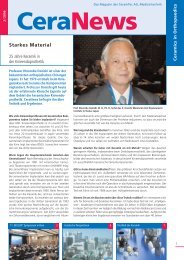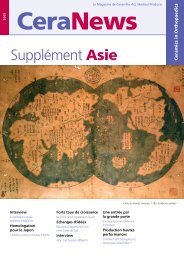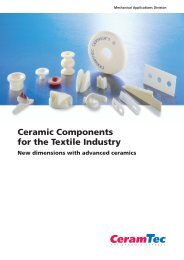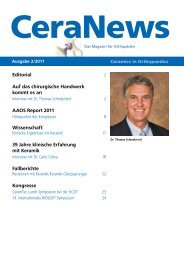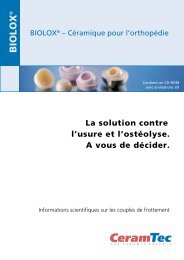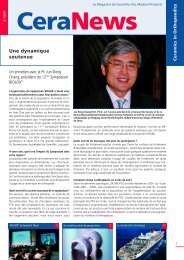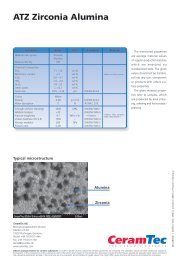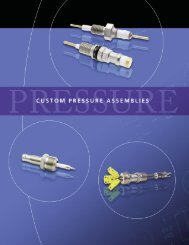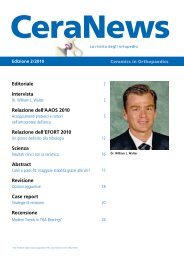Download PDF, 2.4 MB - CeramTec
Download PDF, 2.4 MB - CeramTec
Download PDF, 2.4 MB - CeramTec
Create successful ePaper yourself
Turn your PDF publications into a flip-book with our unique Google optimized e-Paper software.
EFORTHighlights of the 12 th EFORT CongressMore than 6,500 physicians and scientists from 90 countriestook part in the 12 th EFORT Congress, held June 1–4, 2011 inCopen hagen. After last year's success, another "Tribology Day"reflected the great importance attached to tribology. Karl Knahr,MD, PhD (Vienna) once again acted as chairman. Tribology continuesto be one of the most frequently discussed topics in thefield of arthroplasty. As patients are becoming younger andlife expectancy is increasing, calls for bearing couple materialswhich are resistant to wear and tear are getting louder. In theirpresentations, experts repeatedly stressed in this respect thatalongside parameters such as design, wear characteristics andhead diameters, the correct implantation technique also plays adecisive role for the quality of outcomes.Source: <strong>CeramTec</strong>CeraNews 1/2012Tribology overviewTheofilos Karachalios (Greece) reported on theproblem of wear and the bearing couple materialspolyethylene (PE), crosslinked polyethylene (XPE),metal and ceramics. Karachalios voiced the criticismthat despite an abundance of research resultsrelated to tribology problems, long-term clinicalresults are lacking. Therefore, constant critical scrutinyis necessary to ascertain whether data fromthe laboratory can be applied as-is to actual clinicalpractice. He raised the concern that the use of newmaterials and procedures results in new biologicalproblems, something which is discussed primarilyin the context of resurfacing and the trend towardlarger diameter ball heads. It cannot be denied thatthere is a certain amount of pressure from industryto introduce new products, while the cost effectivenessof modern implants in the context of limitedhealthcare system budgets is not yet proven. Whilethere is also a need for modern bearing couples forelderly patients, patients must also be provided withrealistic information about all treatment optionsand the sensible use of the implant.In-vitro findings do not always translate intoclinical success.- Theofilos Karachalios, MDCrosslinked polyethylene (XPE)While conventional PE has proven itself in clinicalpractice, it is subject to load-dependent wear.Crosslinked polyethylene has resulted in a furthersignificant reduction of wear and has thus pavedthe way for implantation in young, active patients.A variety of XPEs based on different manufacturingprocesses are now on the market and aim to strikea balance between strength, resistance to wear andelasticity. The addition of antioxidants is a new andhighly promising approach to prolonging survivaltime. There are conflicting results regarding the biologicalactivity of the wear particles in the nanometerrange, which are smaller than those from conventionalPE. On the one hand, in-vitro studies showthat small XPE particles cause mild bone resorption,while other studies have concluded that XPE particlesexhibit the same biological activity as PE particles.Other studies came to the conclusion thatmacrophages are primarily stimulated by XPE wearparticles and that more inflammatory mediators arereleased than with conventional PE. Furthermore,biological reactions to wear particles vary a greatdeal from individual to individual. Karachalios indicatedthat some experts are critical in their evaluationof the mechanical characteristics of XPE. Thesecharacteristics could make XPE inserts more susceptibleto fractures, which have been reported in publications.Therefore, the use of thin-walled XPE insertsand constrained inserts as well as malpositionedcomponents must be avoided. While conventionalPE has remained a "forgiving" material, when usingXPE it must be ensured that implants are correctlypositioned. Most of the clinical results involving XPEhave been reported in conjunction with metal femoralball heads, while only a few results are availablefor ceramic femoral ball heads.Metal-on-metal (MoM)MoM bearing couples exhibit differences in termsof their material, macrogeometry (diameter andclearance), microgeometry (surface topography)10



